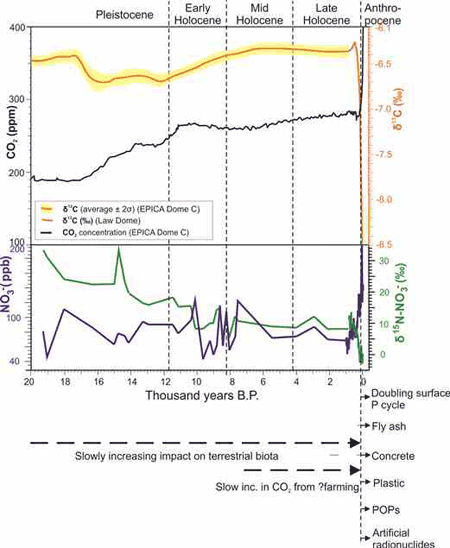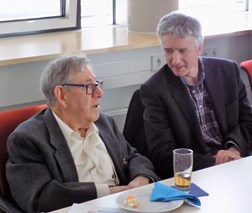 Where are we with the ‘Anthropocene’? Jan Zalasiewicz*, Colin Waters, Mark Williams, Colin Summerhayes and Phil Gibbard explain….
Where are we with the ‘Anthropocene’? Jan Zalasiewicz*, Colin Waters, Mark Williams, Colin Summerhayes and Phil Gibbard explain….
Paul Crutzen, atmospheric chemist and Nobel Laureate, had a moment of irritation and inspiration at a scientific meeting in 2000 in Mexico. Even he probably had little idea how far his idea would travel.
A major player in Earth System science, deeply involved in the International Geosphere-Biosphere Program (IGBP), he had been listening with increasing discomfort to successive accounts describing the alarming rate and scale of global change in ‘the Holocene’. No longer able to contain his feelings, he burst out: “Stop it! We’re no longer in the Holocene but … (he paused) … the Anthropocene!”.
Crutzen’s neologism clearly crystallised an idea that had been developing (unconsciously, perhaps) among other researchers. When Crutzen returned home to Mainz, he found that the same word had been coined independently and used locally by US lake ecologist and diatom specialist Eugene Stoermer. Crutzen invited Stoermer to join him in proposing the term, in IGBP Newsletter, in an article invited, and edited, by Will Steffen (then IGBP Executive Director and key player in the subsequent development of the term among Earth System scientists). Two years later, Crutzen broadcast the term more widely in Nature (see Further Reading).
Livestock
.jpg?h=285&w=259&la=en) The arguments used in both papers included massive change to some of the Earth’s key geochemical cycles (especially of C, N and P), alteration of atmosphere and ocean chemistry, profound biosphere change including conversion of many natural habitats to farmland and a massive global increase in livestock, accompanied by accelerating extinctions, invasions, industrial-scale harvesting of sea-fish, damming of major rivers, etc.
The arguments used in both papers included massive change to some of the Earth’s key geochemical cycles (especially of C, N and P), alteration of atmosphere and ocean chemistry, profound biosphere change including conversion of many natural habitats to farmland and a massive global increase in livestock, accompanied by accelerating extinctions, invasions, industrial-scale harvesting of sea-fish, damming of major rivers, etc.
Picture: Beach deposits at Kampot, Cambodia, with fish (A) and crab debris (B) discarded from a nearby market, along with diverse plastic waste (including bags C, bottles D, lids E, straws F, spoons G), cigarettes (H), pottery (I).... and dead rodent (J). Such diverse potential future fossil/technofossil assemblages are typical Anthropocene indicators, and this deposit almost certainly includes future microfossils too, such as plastic microfibres and fly ash particles. Photo: Colin Waters
All this meant the Earth System had been taken out of its ‘normal’ interglacial state, that the Holocene had ended - perhaps at around the time the Industrial Revolution started - and that a new epoch, the Anthropocene, had begun. The term quickly spread and began to be used in books and papers.
Cut, now, to Burlington House, 17 May 2006, and a meeting of the Geological Society of London’s Stratigraphy Commission. One of us (JZ), as its (then) Chair, introduced a draft manuscript on the Anthropocene for consideration as a Commission publication. The term was just beginning to get enough visibility for stratigraphers to take notice, and its use in literature emerging from the IGBP was generally matter-of-fact - as if it were already an accepted term. However, it was still emphatically informal, having gone through none of the lengthy process of proposal, assessment and ratification by various bodies of the International Stratigraphic Commission, that formal chronostratigraphic terms (like Jurassic, Pleistocene, Toarcian etc.) needed to undergo. The Stratigraphy Commission is not an international body, so cannot ‘adjudicate’ – though it can pass comment. Perhaps somewhat to its own surprise, it agreed (by large majority) that the Anthropocene seemed ‘geologically reasonable’ and might be considered for formalization.
Planetary permanence
This Commission’s cautiously-worded paper on the Anthropocene (authored by all but one of the 22 Commission members) was published in 2008 by the Geological Society of America. It attracted attention, because it made clear that the kind of global environmental changes listed by Crutzen and Stoermer could be permanently imprinted in the rock record and could become geology.
This potential planetary permanence of the consequences of human activities was seen as novel, coming even as a shock to many outside geology (and even to many geologists, who thought ‘man’ too puny to have lasting effects on the planet). As one result, the term began to be adopted and used in disciplines well beyond either geology or Earth Systems science (today garnering some two million Google hits, many in social sciences, humanities and arts).
As another result, there came an invitation from one of us (PG, then Chair of the Quaternary Stratigraphy Subcommission of the International Commission on Stratigraphy (ICS)), to set up a body (the Working Group on the ‘Anthropocene’, to which all five authors belong) to formally examine the evidence as to whether the Anthropocene might become part of the Geological Time Scale, and to make recommendations.
Since 2009 the group has been gathering evidence on what the Anthropocene might be, and whether it really could become a part of formal chronostratigraphy. The membership, currently 33, has an unusual composition in that classical stratigraphers make up only about half the group, the rest being Earth System scientists, ecologists, archaeologists, a soil scientist, oceanographers, historians – even an international lawyer. This is because the Anthropocene sits at the interface of geological and historical time, where modern Earth processes need ‘translating’ into appropriate forms of stratigraphy: landscape change into lithostratigraphy, chemical pollution into chemostratigraphy, biological change into biostratigraphy, and so on.
Solid
Despite this novel make-up, the consideration of ‘human’ phenomena and the very short time-spans, the Anthropocene still needs to be considered in terms of classical stratigraphy. So as well as being a potential epoch, a unit of time and process, it had to work as a physical unit of strata, a potential ‘Anthropocene Series’, just as the history of the Jurassic Period is inferred from the solid evidence of Jurassic System rocks.
So, are there sufficient strata to justify the Anthropocene? A case can be made for this. One feature of the Anthropocene is modern society’s enormous expenditure of energy. It is estimated that humans have expended more energy (largely through fossil-fuel burning) since WWII than in the whole of the preceding Holocene. Part of this has gone towards powering the bulldozers and JCB diggers that have reshaped the landscape, at rates far more rapid than normal ‘background’ erosion and sedimentation.
A rough calculation of how much material is present in all these constructions and in waste by-products (including ‘Artificial Ground’) come to some 30 trillion tons – or some 50kg per square metre. Nor does this figure include ‘classical’ strata (lake and marine sediments, peat bogs, polar snow and ice etc.) which passively trap an array of stratigraphic proxy signals reflecting human impact, much of it novel (agricultural pollen, fly ash, microfossils, plastic). The Anthropocene does not lack for substance. But is it clearly distinct from the Holocene?
Anthropogenic influence has long been a feature of Earth history, from the rolling extinctions of large terrestrial mammals from the late Pleistocene, peaking some 10,000 years ago, and continuing subsequently. Farming, starting near the beginning of the Holocene, has dramatically altered landscapes worldwide, and artefacts are commonly found in Holocene strata.
The Holocene, while showing clear signs of human influence, was, until the late 18th Century, still displaying little overall change to fundamental cycles. Substantial human changes to ecosystems were largely land-based, with only incipient change in oceans. Negligible alteration of the global atmosphere or signal appears within ice-core record, other than a very slow and slight climb in atmospheric CO2 levels from about 7000 years ago, perhaps due to early farming. Stratigraphically, almost all these human impacts were diachronous. Chronostratigraphical boundaries need to be globally synchronous.
Acceleration
 Changes from the late 18th Century, though – particularly from the ‘Great Acceleration’ of the mid-20th Century - were completely different in scale and nature. Take the change to the carbon cycle. For most of the Holocene, atmospheric CO2 levels stayed roughly constant, (260-280 ppm). Around the late 18th Century they began to rise, at first slowly, climbing steeply from the mid-20th to >400 ppm. This is >100 times faster than during the transition from Pleistocene to Holocene, which, stratigraphically, is captured by glacial ice strata and more generally through an equally striking change in carbon isotope ratios.
Changes from the late 18th Century, though – particularly from the ‘Great Acceleration’ of the mid-20th Century - were completely different in scale and nature. Take the change to the carbon cycle. For most of the Holocene, atmospheric CO2 levels stayed roughly constant, (260-280 ppm). Around the late 18th Century they began to rise, at first slowly, climbing steeply from the mid-20th to >400 ppm. This is >100 times faster than during the transition from Pleistocene to Holocene, which, stratigraphically, is captured by glacial ice strata and more generally through an equally striking change in carbon isotope ratios.
Picture: Summary of some key Anthropocene signals (with the carbon isotope anomaly sharp enough to cut oneself on). Reproduced by courtesy. Current Anthropology, Chicago University Press
The change in the nitrogen cycle is yet more profound, and the mid-20th Century also marks the geologically almost instantaneous spread of plastics, concrete, industrial fly ash, many persistent organic pollutants, and a myriad invasive species around the world. This change to the Earth System is now at least partly irreversible (and so will influence the course of future stratigraphy) and has left a near-synchronous suite of fossilisable markers in recent strata – not least many rapidly evolving ‘lineages’ of ‘technofossils’ (pens, bottles, cans, mobile phones etc.).
The Anthropocene has considerable geological reality. The evidence has been widely published and is now being gathered into one large book, for Cambridge University Press (2018). The interim recommendations of the Anthropocene Working Group (presented at the Cape Town IGC in 2016 and published in the journal Anthropocene in 2017) were that a proposal should be prepared for possible formalisation of the term ‘Anthropocene’ as part of the Geological Time Scale, as an epoch (and series), with a base/beginning somewhere in the mid-20th Century.
Formalisation is not guaranteed, and even if accepted, it may not emerge as an epoch/series; a subdivision of the Holocene (subseries or stage), might be preferred. The Geological Time Scale is designed to be stable, so that geologists may communicate across the world and between generations. Success means gaining a supermajority (>60%) of the relevant subcommission, and the entire ICS – as well as ratification by IUGS.
Golden spike
The Working Group is now beginning a new proposal based, classically, on identification and selection of a Global boundary Stratotype Section and Point (GSSP) or ‘golden spike’. The sharpest and most globally synchronous signal is probably the ‘bomb spike’ of artificial radionuclides released by atmospheric nuclear bomb tests. These spread quickly around the world, forming a distinctive marker in all sediments everywhere. The pros-and-cons of different environments – anoxic marine basins, lakes, corals, speleothems, peat bogs, glacial ice, trees and so on – have been assessed for their suitability for hosting an Anthropocene ‘golden spike’, prior to sifting through the many localities where the ‘spike’ might be placed.
We aim to prepare a formal proposal over the next few years. Geological Time Scale work notoriously takes place over a well-nigh geological timescale! Nevertheless, we hope there will be – in the not-too-distant future – a formal decision in sight for the Anthropocene saga, so powerfully shaped by its passage through Burlington House.
Further reading
- Crutzen, P.J. (2002). Geology of Mankind. Nature, 415 (3 January), 23
- Crutzen, P.J. and Stoermer, E.F. (2000). The "Anthropocene". Global Change. IGBP Newsletter, 41, 17–18.
- Waters, C.N., Zalasiewicz, J., Williams, M. et al. (eds) (2014) A Stratigraphical Basis for the Anthropocene. Geological Society, London, Special Publications, 395.
- Steffen, W. et al. 2016. Stratigraphic and Earth System approaches to defining the Anthropocene, Earth's Future, 4, 324-345.
- Zalasiewicz, J. Williams, M., Smith, A. et al., 2008. Are we now living in the Anthropocene? GSA Today, 18(2), 4–8.
- Zalasiewicz, J., Waters, C.N., Summerhayes, C.P., et al. (2017). The Working Group on the Anthropocene: Summary of evidence and interim recommendations. Anthropocene, 19, 55–60.
- Zalasiewicz, J, Waters, C.N., Williams, M. & Summerhayes, C.P. (eds). In press. The Anthropocene as a geological time unit: an analysis. Cambridge University Press.
 Author
Author
Jan Zalasiewicz (pictured right, with Paul Crutzen at a working meeting on the Anthropocene at the Max Planck Institute for Chemistry, Mainz, March 2017) is Professor of Palaeobiology at Leicester University E: [email protected]. He is also a member of Geoscientist’s Editorial Board.
Dedication
This article is dedicated to the memory of Alan Smith (1937-2017), long-standing member of the Stratigraphy Commission and co-author of the 2008 GSA Today paper, who throughout his life was a constant source of help and encouragement to us and to many others in the geological community.